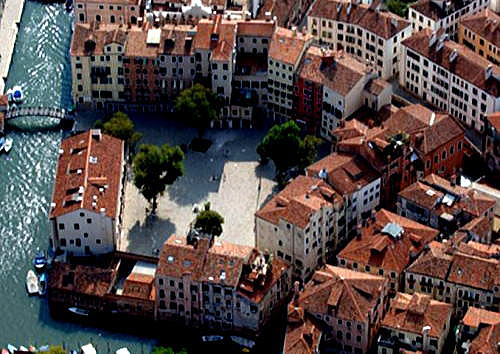| シルクロードの今を征く Now on the Silk Road ヴェネツィア・ユダヤ博物館 (The Jewish Museum of Venice) 青山貞一 Teiichi Aoyama 池田こみち Komichi Ikeda 共編 掲載月日:2019年4月20日 独立系メディア E-wave Tokyo |
| <ヴェネツィア総合メニュー> <博物館1> ヴェネツィア国立造船所1 ヴェネツィア国立造船所2 海洋史博物館1 海洋史博物館2 ヴェネツィア・ゲットー ヴェネツィア・ユダヤ博物館 市立自然史博物館 本稿の解説文は、現地調査に基づく開設に加え、Veneziaイタリア語版を中心にVenice英語版からの翻訳及び日本語版を使用しています。また写真は現地撮影分以外にWikimedlia Commons、さらに地図はグーグルマップ、グーグルストリートビューを使用しています。その他の引用に際しては、その都度引用名をつけています。 ◆ヴェネツィア・ユダヤ博物館  出典:グーグルマップ  出典:グーグルマップ 以下の運河に囲まれた地区が元ユダヤ人ゲットーがあった場所です。  出典:グーグルマップ ヴェネツィアのユダヤ博物館は、単なる説明のための空間ではなく、それ自身の特異性のため、その種のユニークな、広大な博物館、すなわち都市、建築および博物館の複合体です。 ヴェネツィアのユダヤ博物館は、2つの最も古いヴェネツィアのシナゴーグの間にあるGhetto Novoのカンポにあります。 1953年にヴェネツィアのユダヤ人共同体によって設立された小さいけれども非常に豊かな美術館です。 16世紀から19世紀にかけて行われた金細工と織物の製造の重要な例が一般に公開されている貴重物は、ユダヤ人の伝統を生き生きと表現しています。博物館はさらに、古代の本や原稿、そして市民生活や宗教生活のサイクルの最も重要な瞬間に使用されるいくつかのオブジェクトの幅広いセレクションを提供しています。 博物館はユダヤ人の祭りのサイクルと典礼に使われる物に専念する2つの分野で造られます。後者はより多くの教育的アプローチで計画され、イメージと物を通してベネチアンユダヤ人の歴史を扱います。 博物館の最初の部屋は、多くの儀式のある物で最も重要なユダヤ人の祭りのサイクルに捧げられています。ショファ、Channukkiothシャンデリア、Meghillatエステル1個、Menora 1個、そしてPesachの最初のディナーSederのための素晴らしいお皿があります。美術館の最初の部屋には、王冠や尖塔の多くの例、聖スクロールを読むのを助ける小さな手、スクロールを含む箱を開けるための古代の鍵、その他の水差しや盆地で使われている手洗いなどがあります。祈りの製本。 ユダヤ人博物館の科学ディレクターであるUmberto Fortisによって考案された博物館の一部は、ユダヤ人がヴェネツィア滞在中に通過した基本的な段階を理解することを可能にする芸術的かつ文化的なコースを通してあなたに同行したいです。 説明パネルは、様々なユダヤ人民族のヴェネツィアへの移民を示しており、古来の出現を理解するために無視されるべきではなく、残念ながら依然としてユダヤ人に対する偏見を持続させるために、利息の話題を紹介している。 新しい常設展示エリアには、昔から呼ばれていたようにさまざまな民族や民族が表示され、習慣を思い出させ、さまざまな文書や典礼物が展示されています。 ヴェネツィア・ゲットーでの文化生活に関するセクションを利用できる小さな部屋でさえ、そしてただ2つの主要なものを引用するために、rav Leon Modenaと詩人Sara Copio Sullamとして捧げられて、見逃すことができませんでした。 歴史的なセクションの一部は、その貴重な版で世界中で有名なベネチアンユダヤ人の本の取引に専念しています。このセクションは、すでに図書館アーカイブ「Renato Maestro」に保管されている古文書の存在によって貴重になっています。 第二次世界大戦の終わり、shoahの終わり、そして1945年5月3日のシナゴーグの開放による新しい人生の始まりのときに、このセクションはあなたに同行するための全体像で終わりました。 SourcThe Jewish Museum of Venice is not simply an expository space, but a widespread museum, i.e. an urbanity, architectonic and museale complex unique of its kind for its own specificity. The Jewish Museum of Venice is situated in the Campo of the Ghetto Novo, between the two most ancient Venetian synagogues. It is a little but very rich museum founded in 1953 by the Jewish Community of Venice. The precious objects shown to public, important examples of goldsmith and textile manufacture made between the 16th and the 19th centuries are a lively witnessing of the Jewish tradition. The museum furthermore offers a wide selection of ancient books and manuscripts and some objects used in the most important moments of the cycle of civil and religious life. The museum is built in two areas, the first one devoted to the cycle of Jewish festivities and to objects used for liturgy, the latter- planned with a greater educational approach- deals with the history of Venetian Jews through images and objects. The first room of the museum is dedicated to the cycle of the most important Jewish festivities with many ritual objects. You will find shown, among others, shofar, Channukkioth chandeliers, one Meghillat Ester, one Menora, and a wonderful plate for Seder, the first dinner of Pesach. In the first room of the museum, we can also find many examples of crowns and spires, little hands to help the reading of the Holy Scroll, ancient keys to open the ark containing the Scroll and other jugs and handbasins used by priests and examples of prayer bookbinding. A section of the museum, as conceived by Umberto Fortis, scientific director of the Jewish Museum, wants to accompany you through an artistic and cultural course allowing to understand the fundamental stages that Jews passed though in their Venetian stay. The explanatory panels show the immigration of the various Jewish ethnic groups to Venice and introduce the topic of usury, not to be ignored to understand the rise of ancient, and unfortunately still persisting prejudices towards Jews. The new permanent exhibition area shows thus the various ethnic groups or nationi (Nations) as they were called long time ago, reminding their habits and showing a selection of documents and liturgical objects. Even in the small room available a section about the cultural life in the Venetian ghetto and devoted to its most renowned exponents as, rav Leon Modena and the poet Sara Copio Sullam , just to quote the two major ones, could not be missed. A section of the historical section is devoted to Venetian Jewish book trade, renowned all over the world for its valuable editions. This section is made precious by the presence of ancient volumes already kept in the Library-Archive “Renato Maestro”. This section ended with a big picture to accompany you at the end of Secondi World War, the end of shoah and the beginnig of a new life with the opening of the synagogues the 3 May 1945.e:Wikimedia Commons 市立自然史博物館へつづく |